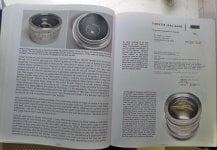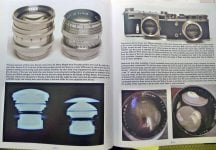dexdog
Mentor
Where to begin... I bought an alleged LTM Sonnar a few months ago from an eBay seller because i had seen a number of similar lenses in the past few years, and was always intrigued by them. Most are marked 5.8cm Sonnar, the one I bought was marked 5cm, but the lens was a bit taller than the usual LTM Sonnar, so I figured it was probably closer to 58mm. Note the crudely scratched aperture index. I compared the field of view of the 5cm with a 5.8cm CZJ Biotar in M42, and the two are identical.




dexdog
Mentor
dexdog
Mentor
I put the lens on my Sony a7iii curious to see if it worked or not, and while I was not surprised that the lens did not work well, but was very surprised to find that the maximum range at infinity focus to was about 19 feet/6 meters or so. The lens was unable to achieve focus on anything farther awy than 19 feet/6meters. Closer than 19feet/6meters the lens focused just fine and took decent images, but the focus scale was way off. I mentioned to Sonnar Brian that given that the lens did not work well, I was thinking of taking the thing apart to see how it was constructed. Brian suggested that would probably be able to get the lens to focus better if I mounted it in an LTM to M adapter that was ground down about 0.5mm or so. Anyway, I ordered an $11 adapter from eBay, ground it down to about 0.6mm flange thickness. I was pleasantly surprised to see that the lens will give good focus at f1.5 at about 100 yards. I took a pic of a truck about 100 yards af f1.5, and focus looks good when I pixel peep. At f2.8, I can tell the truck is a Chevy; at f 4 I can almost read the license plate.
Last edited:
dexdog
Mentor
Pic of the ground down LTM to M adapter. Flange thickness is between 0.60 and 0.62 depending on where I measure, while the standard Leitz adapter is 1.00mm. Given how much the adapter had been ground down, the distance scale has been rotated about 120 degrees to port when attached to the camera using a Voigtlander M to E mount adapter


Last edited:
dexdog
Mentor
This comes under the "Two Wrongs make a Right".
I did something similar with an LTM J-9.
These are odd lenses, some company produced them after WW-2, but has never been adequately explained.
One theory stated they were optics from a STuka Dive Bomber made into a camera lens.
I did something similar with an LTM J-9.
These are odd lenses, some company produced them after WW-2, but has never been adequately explained.
One theory stated they were optics from a STuka Dive Bomber made into a camera lens.
raid
Dad Photographer
Very interesting buy. We get curious, so we buy more lenses. It is a simple logic.
dexdog
Mentor
Sonnar B, I think I understand why reducing the flange thickness greatly improved the abilioty of this lens to focus, but I think it would be better for you to splain why this fix worked.
Infinity Focus requires the lens to be closest to the image plane, as the lens extends from the image plane the point of focus is closer to the camera. Your lens could not get close enough to the image plane for infinity focus. Sice you use a mirrorless camera, which requires an adapter- easy solution was to reduce the thickness of the adapter. The lens will not be accurate with a rangefinder, the Cam was also off. The lens was not made properly, all the ones I've seen like this have a real one-off quality about them. BUT- the optics are decent, and they are unusual. On Ebay- they go for ridiculous money, and are more of an oddity than a good lens. They are not anywhere near as good as a real Sonnar.
dexdog
Mentor
I like to buy oddball cameras and lenses, and play around with them, it is entertainment. In this case, now that the lens in question focuses pretty well I will take a bunch of pics with several CZJ and ZK lenses of similar vintage and do a comparison. Its fun. The historical aspect plays into it too, similar to why I collect ZK lenses and 1950-1956 KMZ J-3s.
Why would anyone buy an early Simlar 5cm F1.5? On the Simlar- the screws holding the mount together have to be placed back into the holes they came out of. Good thing I learned to place screws into separate bins in an ice cube tray. Put the wrong screw into the hole- will jam on the rim. This is the 74th made. It was a mess when received. Again- some aspect of reverse engineering a lens to see how it was made.
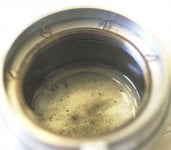

Last edited:
Not shown is the back of the lens, which has a 6-slot spanner ring. The focus mount has an inner mechanism to translate the movement of the 5.8cm optics to the cam for the Leica.
These lenses have been around for a long time on Ebay, some sellers want over $1K for them. At least a few hundred made, they pop up on a much more regular basis than a Nikkor 5cm F1.5.
Some sellers also want over $1K for a Simlar 5cm F1.5. Spend $200~$300 for a 70+ year old lens, about the same as a good dinner out for the family.
I'd pick up the 5.8cm F1.5 "Sonnar" for $200 or so- no problem. Take it apart and finally document the mystery. Sometimes that is the only way to get a clue about who made a lens and what the formula actually is. Years ago I took apart two Nikkor 5cm F1.4 lenses, planning to replace a bad filter ring on a 1950 lens. Discovered that the formula had changed early on, the diameter of the optics and fixtures had been enlarged on the lenses that came out with the Nikon S. Not in any book.
20 years ago I spent $200 on a Canon 50 f0.95 even though people stated using a coke bottle gave sharper images. Bought a pair of them. The coke-bottlers were wrong.
These lenses have been around for a long time on Ebay, some sellers want over $1K for them. At least a few hundred made, they pop up on a much more regular basis than a Nikkor 5cm F1.5.
Some sellers also want over $1K for a Simlar 5cm F1.5. Spend $200~$300 for a 70+ year old lens, about the same as a good dinner out for the family.
I'd pick up the 5.8cm F1.5 "Sonnar" for $200 or so- no problem. Take it apart and finally document the mystery. Sometimes that is the only way to get a clue about who made a lens and what the formula actually is. Years ago I took apart two Nikkor 5cm F1.4 lenses, planning to replace a bad filter ring on a 1950 lens. Discovered that the formula had changed early on, the diameter of the optics and fixtures had been enlarged on the lenses that came out with the Nikon S. Not in any book.
20 years ago I spent $200 on a Canon 50 f0.95 even though people stated using a coke bottle gave sharper images. Bought a pair of them. The coke-bottlers were wrong.
Last edited:


I worked on this lens about 20 years ago- and like Dexdog's lens, was not a 5cm lens- was 5.8cm F1.5. This one has the last digits of the SN in the rear fixture.
My "speculation"- Optics are often finished in batches, and many times the optics are ready before the mechanical fixture. I believe the optics are Zeiss made, for some project during WW-II that was never completed. Have perfectly usable optics, complete them as a Leica mount lens. The "14xxxxx" SN often seen- oddly enough, the very first batch of Fifty 5cm F1.5 Sonnars made in Leica Thread Mount during the 1930s also started with "14". Of course Dexdog knows this.
Last edited:
TenEleven
Well-known
I have an "officially" marked as 5.8cm Sonnar. It's quite a decent performer.
It also had a 'T' mark which someone at some later point tried to scratch out and only somewhat succeded.
Marco Cavinia speculates (sadly in a pay-walled article) that the optics for these came from the "Sturzvisier" of the StuKa dive bomber. The optical diagram of the bomb sight was made by Carl Zeiss and clearly shows a Sonnar design being employed.
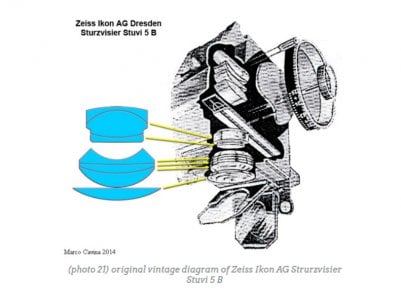
I have taken mine apart because the focus was not correct, and the front element coating was badly damaged to the point where it negatively affected performance. I set the focus correct and polished off the topmost coating layer restoring most of the lens performance, which is quite good. However I would not call it quite as good as the regular Sonnars lending credence to the theory.
It stops down to f/11 (marked) and about f/16 without markings.
When focusing the lens rotates. The lens uses a similar construction and similar screws to my 8.5cm Sonnar.
Also by taking it apart and counting (sub)reflections, I can confirm that it is of a typical 1-3-3 construction.
No surprises there. Spanner slots are however of the usual 2 slotted type. I will take pictures later.
It also had a 'T' mark which someone at some later point tried to scratch out and only somewhat succeded.
Marco Cavinia speculates (sadly in a pay-walled article) that the optics for these came from the "Sturzvisier" of the StuKa dive bomber. The optical diagram of the bomb sight was made by Carl Zeiss and clearly shows a Sonnar design being employed.

I have taken mine apart because the focus was not correct, and the front element coating was badly damaged to the point where it negatively affected performance. I set the focus correct and polished off the topmost coating layer restoring most of the lens performance, which is quite good. However I would not call it quite as good as the regular Sonnars lending credence to the theory.
It stops down to f/11 (marked) and about f/16 without markings.
When focusing the lens rotates. The lens uses a similar construction and similar screws to my 8.5cm Sonnar.
Also by taking it apart and counting (sub)reflections, I can confirm that it is of a typical 1-3-3 construction.
No surprises there. Spanner slots are however of the usual 2 slotted type. I will take pictures later.
If you took pictures of the teardown, Dexdog and I would very much appreciate it if you would post them here!I have an "officially" marked as 5.8cm Sonnar. It's quite a decent performer.
It also had a 'T' mark which someone at some later point tried to scratch out and only somewhat succeded.
I have taken mine apart because the focus was not correct, and the front element coating was badly damaged to the point where it negatively affected performance. I set the focus correct and polished off the topmost coating layer restoring most of the lens performance, which is quite good. However I would not call it quite as good as the regular Sonnars lending credence to the theory.
It stops down to f/11 (marked) and about f/16 without markings.
When focusing the lens rotates. The lens uses a similar construction and similar screws to my 8.5cm Sonnar.
Also by taking it apart and counting (sub)reflections, I can confirm that it is of a typical 1-3-3 construction.
No surprises there. Spanner slots are however of the usual 2 slotted type. I will take pictures later.
dexdog
Mentor
I agree that pictures of the teardown would be interesting!
TenEleven
Well-known
Sadly I can't seem to find the repair pictures, which is annoying but probably mostly due to the fact that I can not recall when exactly I bought this lens, which would help to narrow it down as in a disassembled state a lot of lenses really all look alike.
To leave you not totally feeling unfulfilled, I took it out of its box and at least unscrewed the optical block.
Don't mind the plastic shims. They are my fabrication and not period correct.
One can see immediately that the construction is quite different. First of all there are two helicals in the focus unit.
One drives the rangefinder - the other the lens block. They are linked by a vertical rod so the degree of rotation is the same just the pitch is different.
Secondly the construction of the aperture mechanism is also quite different. It follows the same "idea" as a CZJ Sonnar but the construction (and of course size) is very different. The lens had a later-style black nose but it has worn off. What else? The front element is held in by the name ring. As usual, however if memory serves the middle fixture is a bit different in construction but follows the same "tube-in-tube" scheme.
The focus throw is almost 300 degrees, which I guess is sensible for a lens of that focal length and speed.
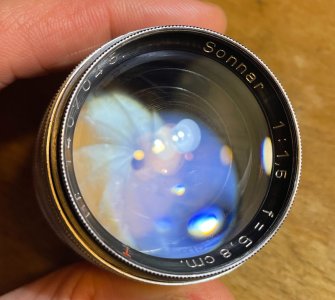
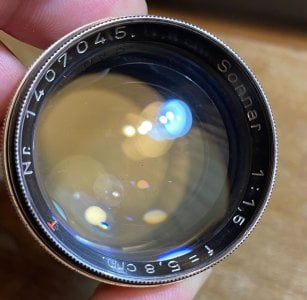
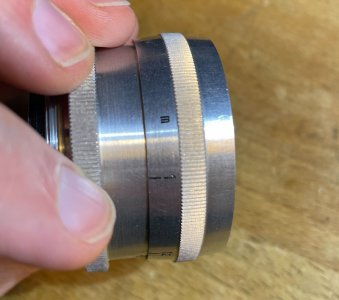
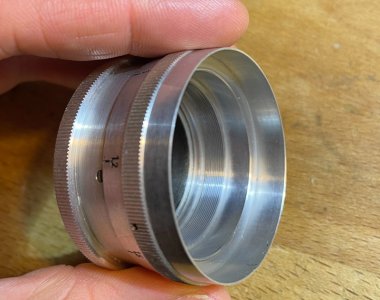
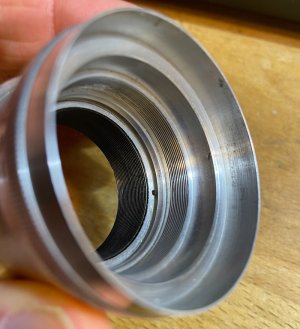
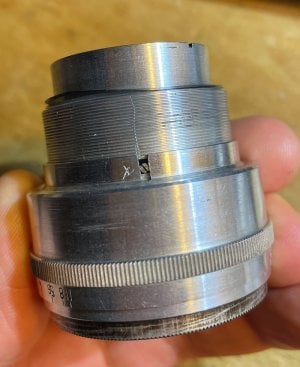
Lastly here is a Japanese repairers blog who has taken a "Leica Sonnar" to its absolute component bits and took a very large amount of pictures.
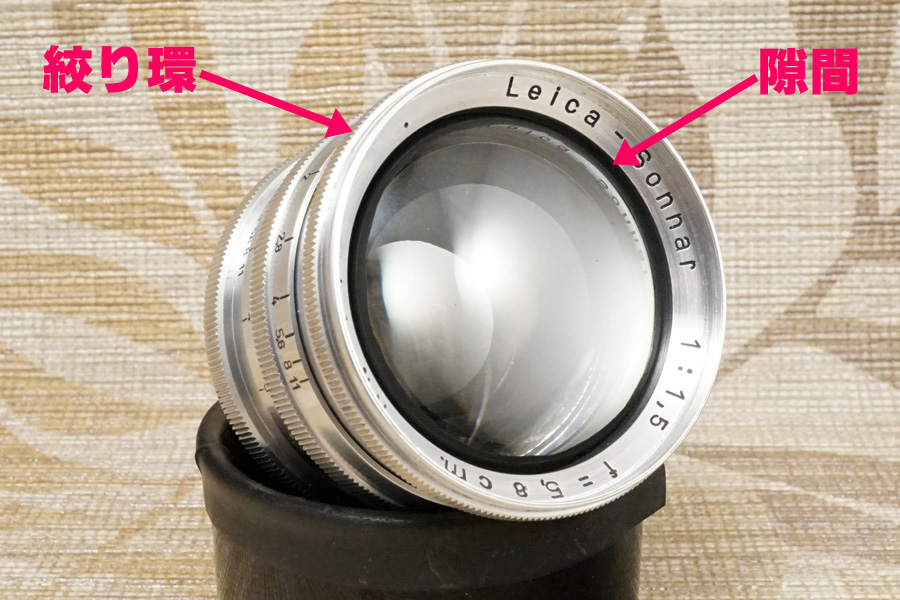
To leave you not totally feeling unfulfilled, I took it out of its box and at least unscrewed the optical block.
Don't mind the plastic shims. They are my fabrication and not period correct.
One can see immediately that the construction is quite different. First of all there are two helicals in the focus unit.
One drives the rangefinder - the other the lens block. They are linked by a vertical rod so the degree of rotation is the same just the pitch is different.
Secondly the construction of the aperture mechanism is also quite different. It follows the same "idea" as a CZJ Sonnar but the construction (and of course size) is very different. The lens had a later-style black nose but it has worn off. What else? The front element is held in by the name ring. As usual, however if memory serves the middle fixture is a bit different in construction but follows the same "tube-in-tube" scheme.
The focus throw is almost 300 degrees, which I guess is sensible for a lens of that focal length and speed.






Lastly here is a Japanese repairers blog who has taken a "Leica Sonnar" to its absolute component bits and took a very large amount of pictures.

◎ 謎のオールドレンズ Leica-Sonnar 5.8cm/f1.5(L39)
(以下掲載の写真はクリックすると拡大写真をご覧頂けます) 写真を閉じる際は、写真の外 (グレー部分) をクリックすれば閉じます ※解説とオーバーホール工程で使っている写真は現在ヤフオク! 出品中商品の
pakira3.sakura.ne.jp
Thankyou- and I can see from the Japanese article why the X-Ray from the article looks as it does. Seems to be fittings around the front element.
SO- a true Sonnar formula lens, probably not originally a camera lens. Optics converted to Leica mount after the war- "transition period". Kind of like converting an optic made for a night-vision scope for use on a camera.
SO- a true Sonnar formula lens, probably not originally a camera lens. Optics converted to Leica mount after the war- "transition period". Kind of like converting an optic made for a night-vision scope for use on a camera.
TenEleven
Well-known
I guess it's obvious from the pictures, but it seems still worth pointing out that similar to Brians' Sonnar posted above the screw thread on which the aperture ring runs and the screw-thread which is used to fix the lens into its focus mount are one and the same. Most likely a labor/time saving measure.
Share:
-
This site uses cookies to help personalise content, tailor your experience and to keep you logged in if you register.
By continuing to use this site, you are consenting to our use of cookies.





